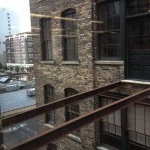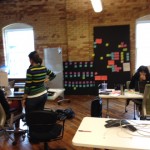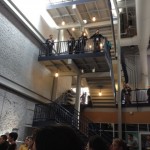In the course of your life, unless you have inherited your family’s Piggly Wiggly fortune, you will have held a number jobs. Maybe you started out in your teens by bagging groceries, or perhaps you filled up that piggy bank by babysitting or mowing lawns. That first job hopefully taught you some valuable lessons about life.
You probably learned that time is money, that you have to work hard in order to do well and keep that job, that learning new skills can be challenging but also rewarding, and that new skills make you better equipped for other jobs in the future. I hope you’ve realized that relationships are instrumental in your success in a role, and that the relationships you build in one job may prove to be a factor in roles you’ll hold down the road.
Undoubtedly, you will have at some point realized you no longer wanted to keep doing the same job. Depending on your circumstances, you may or may not have been able to act on that impulse immediately—many of us certainly have tales of a dramatic exit from a job we’ve held! Hopefully, you gave some thought to your decision to leave the job, but–regardless–you did eventually move on to something else.
Think for a moment about what led you to move on in each job you’ve held over the years. Can you pick up any patterns in your thinking or in the circumstances that triggered your desire to move to the next gig?
This kind of introspection can be illuminating in that it can help you consciously account for the factors that could lead you to stay in a role as it exists, make changes to the role so that you continue to reap rewards in the current position, or determine it is again time to look for that next great adventure.
A few types of job changes
One type of job change can be thought of as linear progression. You start out waiting tables, move up to shift manager, tend bar, manage a store, manage a region of stores, and then run the company. This kind of change tends to value domain knowledge highly: how WE do things in THIS restaurant. It also values generalist knowledge: THIS is how you bus tables, how you handle a customer who’s had too much to drink, and how you report (or don’t report) tips.
Another type of change is when you keep the same role but change companies or divisions. You can be a graphic designer, an insurance salesperson, or a registered nurse just about anywhere because the skills you must possess and the tasks you must be capable of performing well are going to be quite similar anywhere you go. Generalist knowledge is valued here, but more important is subject matter expertise. If you’ve been a nurse for 20 years and have worked in six hospitals across three countries—chances are you’ve seen it all, you’re hard to rattle, and you can do a good percentage of your tasks by instinct while focusing your active attention on more complex challenges.
The last type I’ll mention is what we’re going to focus on today: moving in your career from one archetypal role to another. For example, starting your career as a librarian and then becoming a chemist, followed by a stint as a stunt car driver. This type of change can be very challenging, but very rewarding as well.
One quick note: This can happen within a single organization or it can happen when you leave one company and join another. There will be some differences in how you evaluate the pros and cons of a transition versus an exit, but I believe my experience holds true in both cases.
The more similarities and overlap between these roles, the more your existing knowledge will be useful in the new role, but if you look closely you’ll find there are many skills and realms of knowledge that ARE actually transferrable between widely divergent roles. The real magic happens when you can bring a fresh perspective to the table when tackling challenges in the new role.
I’ll address the following questions based on my experiences in moving from role to role:
- What drives someone to consider a lane change?
- What are some factors to take into account when deciding if the move is the right one?
- What could make your transition more successful?
- What should you expect once you’ve made the leap?
My own experience
In my own career, I’ve been an illustrator, graphic designer, art director, multimedia developer, web designer, web developer, ad operations trafficker, and more. I’ve managed designers, developers, and non-technical folks. I’ve worked on the revenue side as well as the content side of small to large publishing/entertainment properties.
To channel Sesame Street for just a moment, you might imagine that some of these things are not like the others. As a matter of fact, all of these roles share similar aspects as well as having striking differences—and that is a damned good thing.
So what motivated me to consider moving to a radically different position (different at least to outside observers)?
In my role as a visual designer, I designed interfaces for websites and applications. Often my designs would brush up against the edge of what was possible with then-current HTML, CSS, javascript, and Flash. At the very least, some design decisions I made would prove to be problematic for those tasked with building a template from the design. This led to me learning new skills–namely HTML, CSS, javascript, more advanced Flash, and PHP.
Jumping from designer to developer came about to provide a better product (visual design artifacts) in my role as a designer.
I also knew that learning more developer-centric skills would make me a good fit for a far wider selection of jobs in the future. I’d be able to apply for roles that went beyond visual design.
Moving to a new role was in service of increasing job security and preparing for more opportunities in the future than a single set of skills would provide.
Some people prefer to pursue excellence in the same type of role for their whole career. This, however, is not me. I simply get bored with the same role over a long period of time with little to no variation. Now, doing similar things while changing up other elements is another story—for example the context, the complexity, the subject matter, the environment, or the team members. These factors are part of what determines one’s experience in a given job, so changing one or more can significantly extend the period of contentment one feels with that role.
Simple boredom was a significant factor. For me, passion breeds excellence; boredom breeds mediocrity.
In many cases, it can be difficult to get a raise when you hold the same job over a period of years, while a change to a different job entirely is likely to come with amenities: a bump in pay, a cooler title, better facilities, more chances to travel, or more training opportunities. In recent years, the data has shown that those that change jobs every three years or so advance more quickly in their career than those who hold the same positions over longer periods of time.
Compensation and benefits played into my decisions to change jobs each time.
What factors should YOU take into account when considering a lane change?
- The skills you currently have that will be directly or indirectly applicable to the proposed new role. This one will take some reflection, because it’s not immediately apparent what kind of overlap that might exist.
- The obvious/traditional career path the new role would offer, PLUS the flexibility the potential role would add to your repertoire for future lane changes.
- The compensation and benefits offered by current and potential roles, weighed in terms of how much each of those benefits matter to you personally.
- The teams and individuals you do and would work with on a daily basis. When you see folks more days a week than not, you’d better like them! They should compound your enthusiasm, your drive to innovate, and share a similar value system to your own. If there’s a marked difference in culture, values, workflow, or communication styles, don’t take this lightly!
- If you’re pondering a jump to a new company AND a new role, factor in the equity you’ve built in the existing company. Seniority has perks, so make sure the leap is worth your while.
What could make this transition more successful for you?
I’ve found transparency to be effective here. When you are talking with your existing supervisor/peers AND when you talk with the prospective team members—be honest. Tell them where your head’s at, why you want to make the move and how you think your particular background would make you a great fit in the new role.
Ideally, there are real benefits to both teams. In one case, the team I was exiting depended on the team I was moving into for support. They knew that I would carry the concerns and sensibilities forward, and that they would have an inside connection and more responsive support since I knew their pain points.
If you’re leaving your current organization entirely, there will be less overlap in domain knowledge specific to a given company/brand, and significantly less benefit to the relationship aspect—knowing who to deal with in other teams to get things done efficiently or influence strategy outside your new team.
Lesson: Identify and communicate the win-win.
Want to know a surefire way to avoid burning bridges? Ensure adequate coverage for your existing role. Take the time to share with your current team all the intricacies of the things you are responsible for. Verify that all the things you do have a new owner or are at least acknowledged as items that need new homes.
Take it a step further and document all those little nice to know details that people may take for granted you’ll be able to provide if asked. You may not have the luxury of dropping everything in your new role to address someone’s need in a timely fashion, and if you can point them to a resource or forward them a detailed explanation that already exists, you’re ahead of the game.
Lesson: Keep intact the bridges you’ve built. Leave good notes.
Finally, what can you expect once you’ve made the leap?
You’re in the new job now, kicking butt and taking names. Everything is copasetic… except that you keep getting emails, phone calls, IMs, and drive-by visits by folks who just “have a quick question” or would “like your input on something.”
As part of your transition strategy, take the time to negotiate a period of interim support. For X number of weeks, you’re willing to provide limited support of your prior role’s responsibilities (and your new boss has authorized the time to do so.) This makes it clear to all parties that there WILL be some support and eases a lot of fears in the process. It also makes it clear where that line is drawn, beyond which you cannot commit to helping out the old gang any longer.
If you’re leaving your company for a new one, the expectations for interim support are unlikely to be significant. Regardless, making the effort to avoid leaving landmines will be noticed, and good karma never hurts.
Lesson: Set boundaries and stick to them.
Another important step in today’s world is ensuring that your communication channels are updated. Distribution lists, chat rooms, trade publications, physical mailings, and the like all take time to wade through, time that isn’t productive and can extend your on-boarding time as you remain stuck between two worlds.
Lesson: Fill out those virtual change-of-address forms.
Finally, the way you’re perceived by internal and external contacts is something that can take a long time to shift, if it ever does. If you met someone in your role of designer, don’t expect them to refile you under “content strategist” in their head just because it’s so. It may never occur to your team lead that you can put together a styleboard. You will have to be your own champion, diligently switching out your various hats and making opportunities to integrate your different skills into your new role.
Lesson: Habits are hard to change. You’ll need to help that process along.
Final thoughts
Throughout my career, in every case where I have made a significant change in the role I am pursuing, there have been challenges—of course. But I can honestly say that each lane change has led organically to bigger and better things and that I’ve learned a ton, which is a crucial part of my happy place.
Your own lane change may result in a greater appreciation for how other team(s) work and greater empathy in your collaboration with them in the future. It may cause you to realize you actually enjoy the new role more than ones you’ve held before and that you’ve found YOUR happy place. Or you may simply take your new insights in stride, apply it to your growing skillset, and move on again when the time is right.
Nomad or permanent settler—there is no right answer, but don’t be afraid to explore. There’s so much out there to experience, and the knowledge gained and the overlap between roles can be significantly to your benefit, to that of your team, your organization, and, ultimately, your users.
Further reading
http://www.forbes.com/sites/jacquelynsmith/2013/03/08/the-pros-and-cons-of-job-hopping/
http://www.forbes.com/sites/work-in-progress/2012/08/06/8-pros-and-cons-of-job-hopping/
http://danschawbel.com/blog/job-hopping-is-now-part-of-career-management/
http://hbr.org/2012/07/why-top-young-managers-are-in-a-nonstop-job-hunt/
Also published at Boxesandarrows.com/










